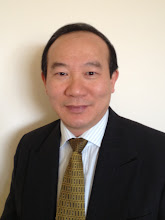In TCM theory, the five elements
(metal, wood, water, fire and earth) and the Yin and Yang are what constitute
the physical universe. The theory of the “Five Elements” is known as "Wu
Xing" in Chinese. To maintain balance among them, these elements support
one another (the generating cycle), and oppose one another (the controlling
cycle).
The
generating cycle of the five elements
The generating cycle of the five
elements describes the consequential series of the elements supporting the
creation of another, which in turn supports the creation of another, and so
forth, in a cyclical fashion:
- Water generates Wood, for without moisture there cannot
be growth.
- Wood is the fuel to create Fire, and it is the action
of heat on organic matter that produces Earth (think of a compost heap).
- Metal and minerals are generated from the Earth, and
these filter and purify the Water that returns to feed the trees. So the
cycle continues.
The
controlling cycle of the five elements
Equally, and conversely, each element
cyclically opposes or controls another element. This cyclical process is
referred to as the ‘controlling cycle’. The controlling cycle exists to balance
the generating cycle and connect the elements, thus forming a complete and
balanced system.
For example, Water will keep Fire in
check and Fire can make Metal usable. The hardness of Metal is required to tame
Wood. Without the controlling structure of roots, the Earth would collapse and
be in disarray. Water is without shape and will always sink to the lowest
level: it is Earth that defines its outline.
Each element is characterised by
certain properties, and is in turn associated with a season (this is with the
exception of Earth, which is present in each of the four seasons). In terms of
bodily functions, this is expressed through the organ relationships between
each of the Five Elements. Each Element has an associated Yin and Yang organ.
The characteristics of the five
elements:
Wood is associated with Spring and
the Easterly direction. This is because the characteristic of wood is that of
germination: spring is the time of germination, as is east is where the Sun
rises, just as plants rise as they germinate. Its corresponding colour is green.
In terms of the human body, in TCM theory, wood is correspondent with the following
components of the human body:
|
Solid
Organ (Zang)
|
Liver
|
|
Hollow
Organ (Fu)
|
Gall
bladder
|
|
Tissues
|
Tendons/nails
|
|
Body
Fluid
|
Tears
|
|
Five
Senses
|
Eye
(Sight)
|
|
Sound
|
Shout
|
|
Emotions
|
Anger
|
These associations are based on the
elemental characteristic properties of wood, and their relationship in the
context of the components of the human body.
Fire is associated with summer, and
the southerly direction. It is characterised by the phase of growth, and the
correspondent colour is red. The corresponding human body functions:
|
Solid
Organ (Zang)
|
Heart
|
|
Hollow
Organ (Fu)
|
Small
Intestine
|
|
Tissues
|
Blood
vessels/ Complexion
|
|
Body
Fluid
|
Sweat
|
|
Five
Senses
|
Tongue
(Speech)
|
|
Sound
|
Laugh
|
|
Emotions
|
Joy
|
Earth is present throughout all four
seasons, but is particularly also associated with the late summer. The corresponding
direction is centre. It is characterised by the phase of transformation, and
the corresponding colour is yellow. The corresponding TCM body functions:
|
Solid
Organ (Zang)
|
Spleen
|
|
Hollow
Organ (Fu)
|
Stomach
|
|
Tissues
|
Muscles/Lips
|
|
Body
Fluid
|
Saliva
|
|
Five
Senses
|
Mouth
(Taste)
|
|
Sound
|
Sing
|
|
Emotions
|
Thinking
|
Metal’s correspondent season is
autumn, and direction is West. It is characterised by the phase of harvest. Its
associated colour is white. The body functions:
|
Solid
Organ (Zang)
|
Lung
|
|
Hollow
Organ (Fu)
|
Large
Intestine
|
|
Tissues
|
Skin/Body
Hair
|
|
Body
Fluid
|
Mucus
|
|
Five
Senses
|
Nose
(Smell)
|
|
Sound
|
Cry
|
|
Emotions
|
Melancholy
|
Water is the phase of the elemental
cycle associated with winter, and the direction of the north. Its
characteristic cyclical phase is that of storage: the storage of energy, as is
the form of water. The corresponding colour to this element is black. The TCM
human body components, thus, are as follows:
|
Solid
Organ (Zang)
|
Kidney
|
|
Hollow
Organ (Fu)
|
Urinary
Bladder
|
|
Tissues
|
Bone/Head
Hair
|
|
Body
Fluid
|
Urine
|
|
Five
Senses
|
Ears
(Hearing)
|
|
Sound
|
Mourn
|
|
Emotions
|
Fear
|
The interrelationships between the
elements in their characteristic properties is applicable to the contexts that
they represent, i.e. the property of certain elements within the generating and
controlling cycles in relation to each other is relevant to their associated
characteristic weather patterns, body functions and can thus be identified and
used in TCM diagnosis accordingly. This is the reason behind the association
with the elements with particular organs of the human body in TCM theory: the
properties of the elements are observed to be applicable in the context of the
human body and its components, and as such so are the relationships between
these components.

